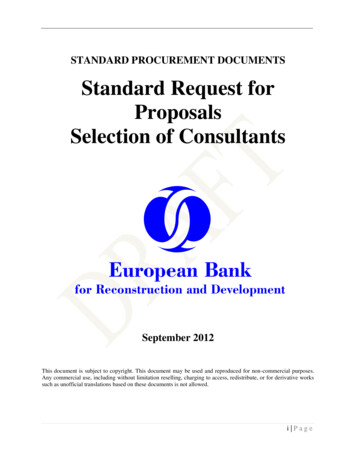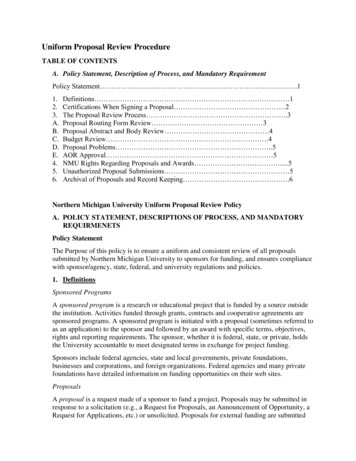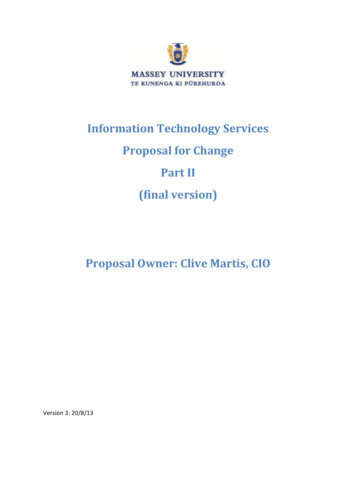
Transcription
International Journal of Arts and HumanitiesVol. 1 No. 4; December 2015A Proposal for Policy Change to SB 722 - Newborn Health ScreeningYamile Marrero, JD, MPH, CSCSClinical Assistant ProfessorFlorida International UniversityNicole Wertheim College of Nursing and Health SciencesModesto Maidique Campusth11200 SW 8 Street, Miami, FL 33199, Building AHC-3, Room 321B, USA.Chanadra Young Whiting Ed.D, MPH/HSAClinical Assistant ProfessorFlorida International UniversityNicole Wertheim College of Nursing and Health SciencesModesto Maidique Campusth11200 SW 8 Street, Miami, FL 33199, Building AHC-3, Room 321B, USA.Lucia SequeiraBachelors of Health Services Administration StudentNicole Wertheim College of Nursing and Health SciencesModesto Maidique Campus11200 SW 8th Street, Miami, FL 33199, Building AHC-3, Room 321B, USA.Marie Carole Sheen – 2853108Bachelors of Health Services Administration StudentNicole Wertheim College of Nursing and Health SciencesModesto Maidique Campus11200 SW 8th Street, Miami, FL 33199, Building AHC-3, Room 321B, USA.Maguy Simeon – 2569940Bachelors of Health Services Administration StudentNicole Wertheim College of Nursing and Health SciencesModesto Maidique Campusth11200 SW 8 Street, Miami, FL 33199, Building AHC-3, Room 321B, USA.Peter Sosa – 4884857Bachelors of Health Services Administration StudentNicole Wertheim College of Nursing and Health SciencesModesto Maidique Campusth11200 SW 8 Street, Miami, FL 33199, Building AHC-3, Room 321B, USA.Tiffany Taylor – 2564550Bachelors of Health Services Administration StudentNicole Wertheim College of Nursing and Health SciencesModesto Maidique Campus11200 SW 8th Street, Miami, FL 33199, Building AHC-3, Room 321B, USA.Nneka Williams – 1633055Bachelors of Health Services Administration StudentNicole Wertheim College of Nursing and Health SciencesModesto Maidique Campusth11200 SW 8 Street, Miami, FL 33199, Building AHC-3, Room 321B, USA.5
Center for Global Research Developmentwww.cgrd.orgMandira Young – 2101726 (Spokesperson)Bachelors of Health Services Administration StudentNicole Wertheim College of Nursing and Health SciencesModesto Maidique Campus11200 SW 8th Street, Miami, FL 33199, Building AHC-3, Room 321B, USA.Manuel Zapata - 4707674Bachelors of Health Services Administration StudentNicole Wertheim College of Nursing and Health SciencesModesto Maidique Campus11200 SW 8th Street, Miami, FL 33199, Building AHC-3, Room 321B, USA.AbstractThis paper aims to inform the reader and address the shortcomings of Florida law SB 722 Newborn Health Screening. The law effective July 1, 2014 requires that every newborn in thestate of Florida is screened for detrimental physical conditions including hearing impairment.Since hearing impairment can significantly affect the quality of a person’s life it is of utmostsignificance that it is identified as early as possible so necessary treatment can take place. Aproposed change to SB 722 - Newborn Health Screening is warranted as the cost of cochlearimplants is minuscule in comparison to the cost to treat the condition over a lifetime. Likewiseprograms providing support to parents/guardians of affected infants are crucial.Keywords: Newborn Health Screening, Newborn Screening Saves Lives Act, Law, PolicyIntroductionWith the health care industry constantly changing there are some changes that affects the public directly whileothers are indirect. In many cases the United States’ legislation has served as a benchmark for new medicaladvances to other countries around the globe. One of the issues that affect many of our children is hearing loss orhearing impairment. In America, approximately 3 in 1000 newborn babies are born with permanent hearing loss(American Speech-Language Hearing Association, 2014). Fortunately, there are organizations and laws that canhelp alleviate this calamity and help relieve the burden felt by parents or/and caregivers. Children who receiveearly treatments have a better opportunity to adapt despite their condition and in the long run have a more stablelife (American Speech-Language Hearing Association, 2014). With this in mind, Florida law SB 722 concerningNewborn Health Screening is of great significance to residents in our community.Introduced in the 1960s, Newborn Health Screening has become a notable and controversial tool in detectinginfantile diseases and disorders. The Newborn Screening Saves Lives Act of 2007, enacted by President GeorgeBush, was designated to provide new screening technology, and a broadened panel of tests, which suggested thatthe states test for twenty-nine core disorders and twenty-five secondary disorders. Once the new medicaltechnologies were implemented, mandated, and publicly funded into a program for all children to be screened, itshould have generated a vast amount of solid evidenced-based material (Alston, 2008). Unfortunately, the policieswere not being properly assimilated or applied and the need for evidence-based programs surrounding newbornand infant hearing impairment require change.Improvements such as demanding 100% of funding from insurance companies for cochlear implants, having moreadvertising campaigns in health care facilities throughout the state, as well as making workshops/presentations forparents whose children are hearing impaired are necessary. With these improvements the law has the potential tonot only enhance awareness of hearing impairment in newborns, but increase the quality of life for these infantsand their parents/guardians who are affected by this unfortunate condition.6
International Journal of Arts and HumanitiesVol. 1 No. 4; December 2015MethodsThe Florida International University Library was used to secure information for this paper. The search began onthe library’s website then “A-Z Databases & Resources List” was selected. “Academic Search Complete” wasused to further isolate related information and the search term “CS/CS/CS/SB 722 - Newborn Health Screening”was entered in the EBSCO Host search engine. A total of 19,341 results came back and after careful scrutiny 4articles were selected for inclusion in this proposed policy change. Another search using the search term “TheNewborn Screening Saves Lives Act of 2007” yielded a periodical and a government summary of presidentialdocuments, the periodical was used to provide supporting details to the proposed changes in this paper.ResultsThe Newborn Health Screening law authorizes the State Public Health Laboratory to provide results of thehearing and metabolic tests or screenings to health care practitioners. It gives audiologists the opportunity toprovide additional information to parents regarding results in order to make an informed decision on obtainingfollow-up care when medically necessary. The law also promotes screening for all newborns identifying riskfactors including but not limited to low income, poor education, and other high-risk illnesses related with anincreased risk of infant mortality and morbidity to provide early engagement, remediation, and preventionservices such as parent support and training programs, home visitation, and case management (The Committeeson Judiciary; Children, Families, and Elder Affairs, 2014, p. 2)). The law also states the importance to identifyscreenings and provide intervention efforts prior to or immediately after birth and up to three months of ageregardless of birthplace. Part of the law requires the patient to be referred to a primary care physician if diagnosedwith an impairment in order to receive adequate treatment and follow-up care. Those infants diagnosed with animpairment from birth to 36 months of age are referred to Children’s Medical Services Early InterventionProgram for continued care management (The Committees on Judiciary; Children, Families, and Elder Affairs,2014, p. 3). Specialists are encouraged to obtain authorization from parents to allow the release of their contactinformation to receive correspondence on early intervention programs directly from those providers. TheDepartment of Health provides a list of specialized healthcare professionals by geographic areas to assist theparents in choosing a doctor.There are potential risks of harm during treatments for those children identified as having hearing impairment;treatments may generate unnecessary worry, lead children to be labeled as having serious health problems, andhave long-term consequences for insurability and employability. If there were at least fair evidence that anintervention was effective, the benefits could be large enough and certain enough to allow a rough judgment thatthey outweighed the potential harms (Shiffman & Spooner, 2001). Individuals who oppose this law might arguethat it might also simply provide no demonstrable health benefit to the children while spending scarce resources.Given tight state budgets for newborn screening programs and other essential child care services, resourceconsumption without benefit must itself be considered a potential harm (Alston, 2008).Having children labeled as having a potential problem with long term consequences is unacceptable. Furthermore,despite the fact that health insurance coverage for cochlear implant services has improved with the majority ofinsurance carriers covering this procedure, we propose that all insurance carriers cover the device, pre and postoperative procedures and any related services at 100% of the cost. The approximate cost of a cochlear implant andrelated procedures inclusive of rehabilitation can cost as much as 100,000.00 (American Academy ofOtolaryngology: Head and Neck Surgery, 2013). According to research conducted by the Johns HopkinsUniversity and the University of California in San Diego, cochlear implantation ranks among the most costeffective medical procedures reported. The results of the study demonstrate that cochlear implantation can resultin a net savings of more than 53,000 per child versus the more than 1 million average expected lifetime cost ofa child who has profound hearing loss prior to language development (American Speech-Language HearingAssociation, 2014)Even though this law currently has a good process in place as far as training programs, there is still some room forimprovement. We propose that advertising campaigns be launched at hospitals, OBGYN offices, children stores,toy stores, etc. to raise awareness of the newborn health screening programs. In order to deviate from therepresentation of illnesses that are seen in a hospital setting, we propose that parent workshops be designed to takeplace at baby/toy stores, coffee shops, or private areas in restaurants. This will provide parents with a morecomfortable environment and stray from the fact that their child has lifetime impairment.7
Center for Global Research Developmentwww.cgrd.orgWorkshops would consist of presentations by healthcare professionals who will promote the importance ofnewborn health screening at birth. Workshops for parents whose children have already been diagnosed willconsist of hands on training on ways to properly care for their children’s impairment.DiscussionHearing loss in neonates and children under the age of 2 is not readily noticeable by routine clinical processes.Parents often report the suspicion of hearing loss and inattentiveness to sound before hearing loss can beconfirmed. The average age of children with hearing impairments in the United Stated is reducing withinformational forums and special programs; such as, Early Hearing detection and intervention (EHDI) programs(Joint Committee on Infant Hearing, 2000). Although children who are diagnosed with hearing impairments ordisability can be identified before the age of 2, these children are often not acknowledged until school age becauseof the nature of hearing loss and the continuous unpredictable response to sound (Year 2007 Position Statement:Principles and Guidelines for Early Hearing Detection and Intervention Programs., 2007).The Joint Committee onInfant Hearing (JCIH) approves initial detection of hearing loss for children through state and national systems ofuniversal newborn screening evaluations. The goal of EHDI programs is to maximize communicative competencyand literacy development for children who are hearing impaired or deaf (Year 2007 Position Statement: Principlesand Guidelines for Early Hearing Detection and Intervention Programs., 2007)As of effective date July 1, 2014, delegates in the Florida House of Representatives in commission with theHealth and Human Services Committee and Harrell joined together to pass the general law SB 722 - NewbornHealth Screening (The Committees on Judiciary; Children, Families, and Elder Affairs, 2014). This policy notonly exists in Florida, in fact another program similar to EDHI exists in Tennessee. This new technology is anelectronic health record called Tennessee Child Health Profile (TN-CHP) developed for infants with disordersdetected by the state Newborn Screening and Newborn Hearing Screening (NHS) programs (Holden-Pitt & Diaz,2006, p. 74). The purpose of this project is to develop the Health Information Technology (HIT) Infrastructure inTennessee to promote and improve the safety and quality of health care for Children with Special Health CareNeeds (CSHCN); in addition, it will develop a comprehensive Child Health Profile for CSHCN based on the sameprinciples of the Child Health Profile developed for infants identified by State Newborn Screening (NBS) andNewborn Hearing Screening (NHS) programs. Lastly, it will promote cooperative agreements between providersof health care for CSHCN and linkages of databases developed by each provider (Holden-Pitt & Diaz, 2006, pp.75-76).Conclusions & RecommendationsIn short, implementing special support groups for parents with children who are experiencing hearing loss andovercoming this impairment with hearing devices and implants of all sorts, especially cochlear implants is withoutquestion, imperative for the affected parties. Furthermore, by requiring all health insurance companies to coverhearing devices, pre/post-operative procedures, office visits, and therapy at no cost to the member, we believe willnot only be cost-effective in the long run, but it will increase the development of a child’s auditory skills andtherefore allowing them to adequately keep up with children of their age when it comes to speech development.For a parent who after the delivery of their child sees that he/she has all 10 fingers and 10 toes, they are alert andfor the most part healthy, then a few days later is informed their child did not pass the Newborn HearingScreening, questions like “where should I go?”, “What should I do?”, and “Who can help my child?” comes tomind. All parents want the best care available for their children. In today’s economy, getting that can be adifficult thing to obtain. If our proposed changes are accepted, into SB 722, we can bring financial relief, provideclear directions on where to go, and supply those parents with support groups who can show them that there arepeople who care and are willing to listen when they have doubts and/or unanswered questions.To date, Florida Law SB 722 has done a great job in advising new parents when their newborn has a hearingimpairment in a timely manner, most times within the hospital, and they have pointed parents in the rightdirection if it is found the newborn did not pass the hearing screening. It is now time for Florida Legislation tonot only point parents in the right direction, but give them the tools needed to help produce extraordinary citizenswho overcame their hearing disability. It is essential to know, that hearing is one of the 5 main senses we ashumans have. The ability to hear not only allows us to listen, but it has a great deal to do with the way we speak.Sometimes we take the ability to hear and speak for granted. But as healthcare professionals, we know, thatgiving a child the opportunity to hear his/her mother and father’s voice for the first time is an emotional andgratifying experience.8
International Journal of Arts and HumanitiesVol. 1 No. 4; December 2015ReferencesAlston, W. D. (2008, June 9). Building a DNA Database. New American , pp. 21-23.American Academy of Otolaryngology: Head and Neck Surgery. (2013, January). Cochlear Implants. Retrievedfrom American Academy of Otolaryngology: ican Speech-Language Hearing Association. (2014, July 20). Facts about pediatric Hearing Loss. Retrievedfrom www.asha.org/policy: ing-Loss/Holden-Pitt, L., & Diaz, J. (2006). Thirty years of the Annual Survey of Deaf and Hard-of-Hearing Children andYouth: A glance over. American Annals of the Deaf, 143(2), 72-76.Joint Committee on Infant Hearing. (2000). Year 2000 Position Statement: Principles and Guidelines for EarlyHearing Detection and Intervention Programs. Pediatrics, 106(4), 798-817.Long Description for New Cochlear Implants in 2001. (2012, October 16). [NIDCD Health Information].Retrieved July 22, 2014, from ong-implants.aspxShiffman, R., & Spooner, A. (2001). Information Technology for Children's Health and Health Care. Journal ofAmerican Medicine Information Association, 8(6), 546-551.The Committees on Judiciary; Children, Families, and Elder Affairs. (2014). CS for CS for CS for SB 722Newborn Health Screening. Retrieved from The Florida 722/BillText/c3/PDFU.S. Department of Health & Human Services. (2012, November). Text Description for Age at Which HearingLoss Begins. Retrieved from National Institute on Deafness and Other Communication cs/pages/long-begins.aspxUse of Hearing Aids by Adults with Hearing Loss. (2012, October 17). Use of Hearing Aids by Adults withHearing Loss. Retrieved July 22, 2014, from earingaids-adults.aspxYear 2007 Position Statement: Principles and Guidelines for Early Hearing Detection and Intervention Programs.(2007). American Academy of Pediatrics, 898-921.AppendixAppendix A: Age at Which Hearing Loss BeginsThe following table depicts the results from a National Health Interview Survey, conducted in 2007 and 2012.The data is organized by percentage distribution by sex and age, based on subjects' report of any permanenthearing loss (U.S. Department of Health & Human Services, 2012). When the impairment is identified at birth,the individuals and their parents can gain access to resources to help them.FemaleMaleBirth220–2 years323–5 years326–19 years121120–39 years203240–59 years303260–69 years141270 years1689
Center for Global Research Developmentwww.cgrd.orgAppendix B: Use of Hearing Aids by Adults with Hearing LossThe National Institute of Health showcased the following graph on their website, the 2010 target lines representthe goals recommended by the Hearing Health group, which were discussed and approved by the FederalInteragency Working Group for Healthy People 2010 (Use of Hearing Aids by Adults with Hearing Loss, 2012).Appendix C: New Cochlear Implants in 2001This chart was created by the Health Promotion Statistics Branch, NCHS, CDC and the Epidemiology andStatistics Program, NIDCD, NIH. Notice the number of cochlear implants needed for children under 6 years ofage per 10,000 deaf or very hard of hearing persons (Long Description for New Cochlear Implants in 2001, 2012).Rate per 10,000 Deaf orVery Hard-of-Hearing PersonsAll Ages, Male and Female 51Female64Male43Under 6 years1,0356–17 years8418–44 years4845–64 years5465 years and over1810
Nicole Wertheim College of Nursing and Health Sciences Modesto Maidique Campus 11200 SW 8th Street, Miami, FL 33199, Building AHC-3, Room 321B, USA. Tiffany Taylor - 2564550 Bachelors of Health Services Administration Student Nicole Wertheim College of Nursing and Health Sciences Modesto Maidique Campus 11200 SW 8th Miami, FLStreet, 33199 .











